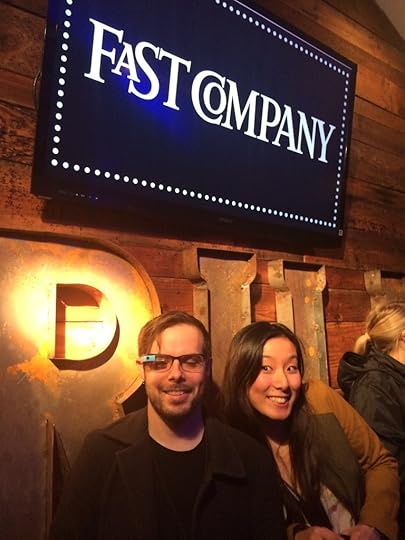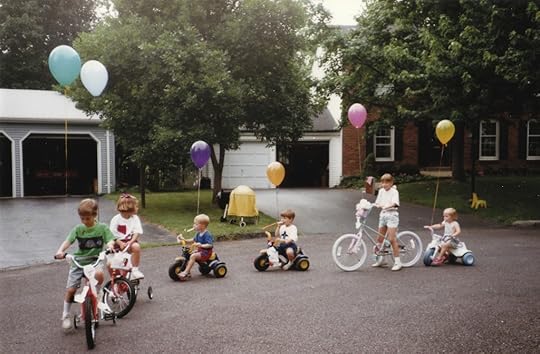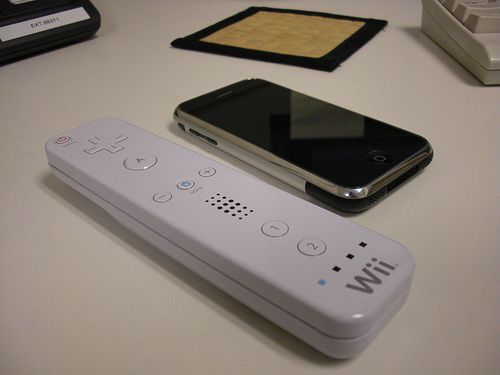Randi Zuckerberg's Blog, page 48
March 25, 2014
Move Over, #TBT…#TGT is here
Lately, I have been looking forward to Thursday more than most other days in the week. You might be wondering why…well there are a couple reasons. Yes it is Fridayʼs Eve, but more importantly it is #tbt or “throw back Thursday,” a day that so many friends from elementary school, high school and college put up some really funny memories. Every time I visit my parents, I run to my old bedroom and search through all of the photo albums to scan for #tbt. Every week is nostalgic and puts a smile on my face.
So this week, I started to type in #T into twitter and the first hashtag that popped was #ThighGapThursday. What??? I was speechless. This must be a viral hoax much like #BikiniBridge. After some research online, #ThighGapTursday is not a hoax but a day in which people celebrate “thigh gaps.” So what exactly defines a “thigh gap?” According to Wikipedia, it is a space between the inner thighs when standing upright with both knees touching. This phenomena started in 2012 after the Victoria Secret Fashion Show, in which several models has pronounced thigh gaps and a new body ideal was born.
With summer quickly approaching, girls are pinning their #thinspiration or #thinspo boards full of bikini bridges & thigh gap diets, exercises and “thin” inspirations. So is the thigh gap natural? Attainable? The answer is yes to both. Ok, let me clarify. Yes, a very very very small percentage of women naturally have a thigh gap due to the shape of their pelvis, body structure and muscle mass. For the majority of us, the thigh gap is a fleeting thought because it is simply unattainable; however, with social media at our fingertips we are are constantly inundated with ads, photos of models and friends with this unattainable ideal which now feels like the norm. This norm has us pinning unhealthy body images of protruding hipbones that make our bikini bottoms have bridges and ways to attain a thigh gap to name a few. In the olden days we would see airbrushed ads on billboards or magazines so it would take years to create a new norm but now we see hundreds of images all day long on Facebook, Twitter and Instagram, so a “new” norm can be born and viral within in hours.
I wonder how we, as women and mothers, can change this competition for “perfection.” How can we empower young girls to begin loving who they are without feeling the need to “fix” themselves. How do we teach our next generation to embrace their differences?
According to the National Eating Disorder Awareness organization, 40-60% of girls 6-12 are concerned about their weight or becoming fat. This statistic breaks my heart. This is an age where girls should be focusing on having fun and being carefree. How can we use our social media outlets to reverse this movement? Will campaigns like Miss Representationʼs #NotBuyingItʼs and Doveʼs #RealBeauty movement encourage our generation and the next generations to embrace our natural variations and cause us to focus on building inner confidence? Time will tell.
In the mean time, I know that I can do my part today by focusing on eating healthy, working out in moderation, learning to love my body and not embracing unhealthy ideals. I can actively make the decision to not “like” ideals that do not promote healthy lifestyles for women. Are you with me?
Posted on 3/25/2014
 Written by Veena Goel Crownholm
Written by Veena Goel Crownholm
Veena Goel Crownholm is a UCLA grad and former Miss California. Prior to having her son, she worked in the non-profit field doing special events and program development as well as working as a Program Officer for the Thomas J. Long Foundation. In 2010, after she had her son, she began her career as a Lifestyle Contributor both online and on-air, as well as motivational speaking. She enjoys DIY projects, Thrift Store/Flea Market hunting, Camping and Hiking. She lives in the San Francisco Bay Area with her husband, son and 3 puppies. For more information on Veena please visit www.VeenaGoelCrownholm.com or follow her at: www.TiarastoBabies.com or on twitter @TiarastoBabies



 by
by 
The post Move Over, #TBT…#TGT is here appeared first on Dot Complicated.
March 19, 2014
10 Things My Kids Will Never Have To Worry About Thanks To Technology
So maybe I didn’t have to walk up hill — both ways — in the snow to and from school, but that doesn’t mean my generation didn’t have its own challenges. And, thanks to technology, here are just a few of the things my kids will never have to worry about. Do any of these sound familiar?
1) Learning to fold binder paper into perfectly passable triangles.
2) Calling Popcorn (767-2676) to get the correct time to set the clocks after the power goes out.
3) Putting a tape recorder up to the stereo speakers and waiting for that awesome new song to come on the air, and onto the blank tape.
4) Then hoping the DJ says the name of the song, and the artist, but not — absolutely not — over the rockin’ instrumental intro.
5) Watching parents argue over a paper map while driving. (Or fold it, for that matter.)
6) Hearing the camera click, and the film rewind, right before that all-important picture-taking moment.
7) Waiting to go to the bathroom or grab a snack or answer the phone until a commercial break.
8) Wondering if a pesky sibling is listening in on a private call from the phone in the other room.
9) Carrying spare change or memorizing a calling card number for a post-practice-pick-up payphone call.
10) Having to spell whole entire words and use proper punctuation.
Phew, being a kid in the good ol’ days was no joke. (And I have the paper cut scars to prove it.)
Posted on 3/19/2014
Amy Heinz is a San Francisco Bay Area mom of three and the writer behind Using Our Words — a parenting blog filled with lessons she’s learned (usually the hard way), laughs she’s enjoyed (mostly at her own expense), and tears she’s shed (this mama’s got heart). You can also find her on Facebook and Twitter.



 by
by 
The post 10 Things My Kids Will Never Have To Worry About Thanks To Technology appeared first on Dot Complicated.
March 18, 2014
That’s A Wrap: Another SXSW Is In The Books
Depending on your budget, stamina and opinion of Tex-Mex cuisine, the thought of spending a whole week in Austin for the annual South By Southwest (SXSW) Film, Interactive and Music Festival may trigger varying levels of anxiety. Factor in this year’s dose of inclement weather, followed by a senseless tragedy that, for many, hit close to home, and your attendance at the festival to end all festivals might become further complicated. But for those who are truly focused on the rapidly evolving intersection of media, entertainment and technology, one week spent at SXSW affords ample access to the thought leaders, industry trendsetters and emerging platforms that are likely to affect the future. Simply put, the entire conference is now a must-attend.
SXSW Interactive attendees have traditionally extracted value from the festival through many different outlets. However, this year, as Fortune reporter Erin Griffith and several other panelists observed, there appeared to be a greater shift among many towards private intimate gatherings and away from large corporate-sponsored activations. Among the most high-profile intimate gathering venues was the Fast Company Grill, which hosted an invitation-only mix of journalists, product evangelists, startup accelerators and founders. Fullscreen, a YouTube- and Vine-based content creator network hosted a similarly small-yet-fun event for its clients and friends. Those seeking an even more streamlined crowd could have opted for Gary Vaynerchuk’s #SecretWineParty, or cocktails within the familiar confines of the lobby lounge at the Four Seasons hotel. Yet, there was no shortage of venues for companies to showcase recently-launched products, and some of these areas (including the PayPal Lounge, which hosted a chat with Randi Zuckerberg) also doubled as fully-functioning workspace lounges.

Warm post-panel exchange between Ben Horowitz (Andreesen Horowitz) and Nas.
As SXSW has grown in size and scope, the lines between Interactive and Music (both of which overlay Film) have become increasingly blurred, and this was perhaps most evident during “The Hard Thing About Hard Things” a panel in which Ben Horowitz, VC at Andreesen Horowitz, and renowned hip-hop artist Nas engaged in a friendly panel discussion centered around handling difficult decisions and overcoming challenging business cycles. The following day, Pepsi sponsored an exclusive bioreactive concert featuring A-Trak that was powered by Lightwave, a company that creates augmented nightlife experiences by collecting and analyzing user data through its wearable wristband technology. Further examples of Interactive and Music convergence included the Official SXSW Interactive Closing Party, which was hosted by Media Temple in celebration of Def Jam’s 30th Concert Series which featured Jay-Z and Kanye West, and Kanye West’s G.O.O.D. Music Showcase, which was hosted by Yahoo!

Timothy Jordan, Developer Advocate for Google +, and a friend at the Fast Company Grill.
The massive user uptick in streaming music services and launches of hardware (Aether Cone, etc.) with music-related artificial intelligence components that have transpired since last year’s SXSW also served to extend Interactive themes into the Music portion of the festival. What’s Trending’s Shira Lazar, DJ Skee of Skee TV and both Russell Simmons and Steve Rifkind of the All Def Music led a thought-provoking panel on the significance of YouTube as a tool for artist discovery, content development and monetization. Spotify House maintained its position as a default venue for emerging recording artists, iTunes Festival featured Grammy-nominated Kendrick Lamar, and on the media side, The FADER, FILTER and Elliot Wilson’s Rap Radar blog hosted music showcases or panels featuring Damon Albarn, Banks and Lil’ Wayne, respectively. A week removed from the office or your normal work environment can feel like an eternity away from the staff, processes and technology that make your business go, but the sheer magnitude of interaction, innovative thought and trendspotting that occurs among some of the brightest leaders in the media, entertainment and technology space during SXSW Film, Interactive and Music makes for a smart investment of time, energy and other resources. Words to the wise: register and make your accommodations early, download the app and carefully plan the little down time you will have in order to make your extended Austin stay worthwhile.

Angel Headrick, Braintree-sponsored SXSW pedicabber and UT-Austin student.
Posted on 3/18/2014
Harold Hadnott is a Managing Partner at Beverly Hills, CA-based H2KREATIVE, an innovative business and brand development, content production and talent cultivation platform focused on the media, entertainment and technology space. He founded the company following a successful stint on Wall Street where he advised Silicon Valley entrepreneurs, venture capitalists and executives on pre- and post-liquidity event investment strategies. Harold can be followed on Twitter at @HaroldHadnott.



 by
by 
The post That’s A Wrap: Another SXSW Is In The Books appeared first on Dot Complicated.
March 17, 2014
The Streets Are Empty….Kids Aren’t Playing Outside, And It’s A Problem
When my children were little I would tell them to go outside and play for 30 minutes. I would call my neighbor friends who would tell their children the same thing. We were fortunate that all the parents in the neighborhood believed in the benefit of outdoor play.
We emphasized the 30-minute rule. The children went outside in all types of weather. Thirty-minutes gave them enough time to get involved in a game or project and often they would be outside a lot longer. (My husband often would come home from work at 6:15 and find the children playing in the front yard in the dark.) They would play games, sing songs, build forts, ride bikes, create plays and play all types of games of imagination. They would love the unstructured time to explore and learn about life.
Today, I don’t see many children playing outside. I’m worried that in an attempt to provide the best for our children, many parents are driving their children to structured activities and giving them all the latest technology, but they have forgotten a key component to childhood. Children need unstructured play and they need to play with children of different ages, such as in a neighborhood. They need fresh air and the sense of wonder that comes with exploration of the outdoors.
They need to use their imaginations. The benefits of playing outdoors are many. My children gained independence and learned how to resolve conflicts. They learned how to get a long with friends and how to cooperate with others. They enjoyed the benefits of physical exercise. They learned how to cope when things didn’t go their way. They learned how to express their opinions and persuade others to follow their ideas.
In his book, Brain Rules, John Medina shares his thoughts on the importance of exercise, “To improve your thinking skills, move. Exercise gets blood to your brain, bringing glucose for energy and oxygen to soak up the toxic electrons that are left over. It also stimulates the protein that keeps neurons connecting.” It is so important to get outside and play to help stimulate the brain.
Sometimes people hesitate to have children play outside if they think the weather is bad, but as Sir Ranulph Fiennes wrote, “There is no bad weather, only inappropriate clothing.” All types of weather encourage different play outside. My children played in snow pants, rain boots, swimming suits and any type of clothing that allowed them to be outside in all types of weather. “Sunshine is delicious, rain is refreshing, wind braces us up, and snow is exhilarating; there is no such thing as bad weather, only different kinds of good weather,” writes the 19th century author John Ruskin.
So try the 30 minute rule at your house…maybe start with 15 minutes and check out the book, 15 Minutes Outside, by Rebecca Plants, for some suggestions of things to do outside with your child. However, if you make daily outdoor play a priority, your children will have their own ideas and soon they will be creating their own games, engaging in play with their friends and enjoying the benefits of playing outside.
Posted on 3/17/2014
Written by Mary Pat Pautler
Mary Pat is a preschool teacher, mother of three, and grandmother of one. She lives in St. Louis, MO, with her family.



 by
by 
The post The Streets Are Empty….Kids Aren’t Playing Outside, And It’s A Problem appeared first on Dot Complicated.
March 14, 2014
3 Big Trends From SXSW
Seventy-two hours in Austin yielded more than a few Pedi cab selfies and kimchi fries. This year’s discussions felt significant, moving past our obsession with technology and grappling instead with its role in our world. Below were three trends that I couldn’t ignore.
DISPOSABLE MEDIA:
With Edward Snowden and WikiLeaks developer Julian Assange taking the stage (or at least the Skype) at SXSW, government surveillance and privacy issues were hot topics. Interestingly, the issues that these conversations brought to light seemed to bring about a craving for a new type of media, deemed “disposable.” From SnapChat to Secret, apps and innovation that allow people to erase their past, not create one or remain anonymous took up headspace at the festival. One wise panelist commented that this trend was “the burning man of media,” and is necessary in light of a culture that is scared to leave anything behind. Expect to see more technology emerge in this space as we all seek greater anonymity. Consider the trend an antidote to big data.
WEARABLES ARE THE FUTURE (FOR MARKETERS):
As wearables are becoming more mainstream, conversations turned to how marketers should be thinking about them. The most insightful point was shared by Soulaiman Itani CEO & Founder Atheer, who told us that the more personal the wearable, the more personal a marketing communication should be. As our habits have changed from TV, to web, to mobile, media has evolved coming closer to home and providing us more tailored and relevant messages. Wearables will put this customization on steroids offering messages that bring utility, information and more seamless interactions with our greater community. One daring example was debuted at the Fast Company grill where guest attendees wore bracelets that sourced their energy to determine the mood of the evening and hence the next song to be played. Life changed.
“GIRLS” POWER:
From Mindy Kaling to Lena Dunham and countless other panels featuring fierce female bloggers and entrepreneurs, Austin was leaning in to the gender conversation in an exciting way. During her panel, “Queen of Comedy,” Mindy Kaling made an important statement about women and how they are pitted against one another. She said that “Women are constantly put into pageants that they don’t want to be in” and further underscored her argument by pointing out that while she is painfully compared to Tina Fey and Amy Pohler, society does not evaluate male comedians by putting them in a competitive set. Lena Dunham coached us all to tell our authentic stories because if we didn’t, who would? She talked about rewriting the script for women in a way that would favor authenticity while busting stereotypes. Both agreed that despite progress, we still have miles to go but that the cause would be advanced if we each embrace characters onscreen and off screen that are full of contradictions, quirks and “weirdness.” A perfect call to action for Austin, and everywhere.
What did you see, hear or tweet? Did it matter?
Posted on 3/14/2014
 Written by Adrianna G. Bevilaqua
Written by Adrianna G. Bevilaqua
Adrianna is the Managing Director of Creative & Strategic Planning at DeVries Global, a PR and Social media firm. She is the founder of Techromance, a blog that examined the intersection of dating and technology and continues to be fascinated by how social media has changed from a reflection of how we communicate IRL, to a force that shapes how we relate to each other. She has guest blogged for Social Media Week, PR Week, the College Crush and Dot Complicated. Follow her on Twitter at @adriannagiuls.



 by
by 
The post 3 Big Trends From SXSW appeared first on Dot Complicated.
March 13, 2014
Learning To Accept Mistakes, Mix-Ups, And Free Massages
It was the Friday afternoon of Valentine’s Day and I was heading into San Francisco for the weekend for the Wisdom 2.0 conference. I pulled into my hotel just with enough time to hear the opening address. As I’m checking into my hotel, I see a masseuse with her massage table walk into the lobby, and I thought to myself, “That’s cool! Someone is getting an in-room massage!” I am a self-proclaimed massage snob and all I ever really want is a massage. To me, it is the ultimate.
While waiting, I strike up a conversation with the bellman, Duncan, about my love of the glowing Buddha that adorns each hotel room. As we discuss the true nature of Buddhism, I confess I’ve always wanted a glowing Buddha but feared the bad karma that would follow taking a Buddha. He poignantly pointed out that with Buddhism there is no sense of possession, and all is universal, that it really is quite possible the Buddha should really belong to me. Laughing at the duality of this conversation, we make down the hall to my room to find the masseuse from the lobby standing at my door. Duncan says, “Oh, looks like you’re getting a massage!” and with a strange feeling arising in me, I am confronted that for the very first time in my life, I didn’t want a massage! I was ready to drop my bag in my room, run across the street, and be in a room with 2000 other like-minded mindful people anxious to get the weekend started.
The tiny masseuse said to me in “Happy Valentine’s Day! This is a gift from your husband.” Wow! What a guy! Even though we said we weren’t going to exchange gifts, this was so thoughtful. I wondered how he knew of my exact timing of arriving at the hotel and how he knew that I wasn’t going to just drop off my bag and go straight to the conference? As questions arose in my mind, I confronted the true issue at heart that for the first time in my life, I really was not in the mood for a massage. I had never experienced that feeling before! What was I to do?
Knowing that there are no accidents, things happen for a reason and that timing is everything, I am strong enough in my practice to know that I just had to go with the flow. Clearly the message here was that I needed to slow down and be with what is. And what is, in this moment, was a woman telling me to undress and lie face down. I quickly text my husband and tell him, “Masseuse just arrived, thank you!” Then I turned off my phone, lay on the table, fought myself for not wanting to be there, and just accepted that this was exactly where I was supposed to be.
Continuing to breathe and let go of my resentment for missing the opening speaker, I consciously chose to embrace gratitude for this unexpected gift, and I slowly began to embrace the moment and this surprisingly good massage from this really tiny, seemingly very strong masseuse. Because of her size, she actually crawled up on top of me and used her whole body weight to put pressure on my sore shoulders and lower back. Not really sure of her exact position, at one point it felt like she was on all fours, when all of a sudden I heard her talking on her phone. She was whispering, “I’m in the middle of a massage…” when she proceeded to climb off of my back and walk into the bathroom to continue her conversation.
She came out and started to speak very quickly, apologizing that she was in the wrong room and that this massage was not actually meant for me. Laughing inside over the irony that I didn’t even want the massage, and then I had to come to accept that it was meant for me, when in fact it wasn’t meant for me at all! I proceeded to get off the table, wrap myself in the massage sheet and walk over to my purse to pull out $20 to tip her. She then tells me that she normally charges $80 for 30 minutes, but because of her mistake she would only charge me $60. At first I was really annoyed that now I had to pay for this, but thinking again about good karma, I filled out the paper to charge it to my room, and said goodbye.
Luckily she didn’t use any massage oil and as soon as she was gone, I was able to quickly get dressed and head over to my conference. All the way down the elevator I was laughing over the mishap, and happy that I had learned the lesson I was supposed to learn: Sometimes you have to let go of attachments to the ways you thought things were supposed to be, and accept what is. I had to accept the fact that I needed to slow down, be present, find time to breathe and be in the moment. Even if what I was presented in the moment was meant for someone else, I could still find value in the messages the universe was offering.
Oh, and as I got into the hotel lobby, I found Duncan the bellman, and told him that after our whole conversation, it turned out that my room had no glowing Buddha. I guess someone had already decided to take it. It was then that I realized I didn’t need a glowing Buddha; my Buddha was within.
Posted on 3/13/2014
Joree Rosenblatt has a Master’s in Counseling Psychology and is a mindfulness educator in the Bay Area. In addition to working at a K-8 private school teaching mindfulness to students, she teaches her original curriculum to adults, and onsite in corporations, in the Fundamentals of Mindfulness and Mindful Parenting. Joree’s true passion is raising her two daughters, mindfully of course…well, most of the time! Even though she already is a rock star mom, Joree practices mindfulness every day, and when all else fails, she remembers to take a moment and just breathe.



 by
by 
The post Learning To Accept Mistakes, Mix-Ups, And Free Massages appeared first on Dot Complicated.
March 12, 2014
How Tech is Enabling Holistic Care
Homeopathy is a holistic system of medicine that provides deep healing and works on all levels: body, mind, and emotions. Originating over 200 years ago in Germany, it is used today by over 500 million people around the world to treat chronic and acute illnesses. In Homeopathy, disease or symptoms are regarded as the body’s warning signs, designed to gain our attention. The homeopathic treatment addresses the root cause of disease by activating the body’s own powers of self-regulation. Remedies are natural, FDA-regulated, and are extremely safe to use even with babies and pregnant women.
Finding the right remedy for your symptoms and condition is essential. When the right remedy is taken, healing can be sustained in the long-term and brings one’s holistic health into balance. When one doesn’t take the “right” remedy, the effect is like taking a placebo.
How can I find the right remedy that matches my symptom profile?
Nothing beats working with an experienced, highly-skilled and certified practitioner, called a homeopath. While there are only 5000 of them in the US and you may not find one in your hometown, there are online and mobile ways to seek treatment. Fortunately, many very experienced homeopaths find identifying the right remedy to be more effective via online communication via video Skype or FaceTime as they get to see the patient in their most comfortable setting at home where they are most relaxed.
Here are some online and mobile tools for seeking homeopathic care:
Homeosity’s Personalized Online Treatment Program is a simple online and mobile way for people with chronic conditions, troubling symptoms or acute ailments to seek treatment from certified and highly-experienced homeopathic practitioners. You can sign up for a free, 20-minute private consultation over Skype, FaceTime or phone here.
ABC Homeopathy’s Simplified Online Remedy Finder is a free online tool that is a useful way to address common acute ailments like flus and colds, ear infections, digestive issues, eczema, migraines, recovery from accidents and surgeries. As the tool may recommend a handful of remedy options, some research may be necessary to identify the one that is most suitable.
Remedy Finder from Ainsworths is an educational tool that enables you to appreciate the concepts of homoeopathy and how it can be applied to determine a remedy for a number of common, self-limiting and acute conditions. It is designed to assist you to find the most suitable remedy for your symptoms from Ainsworths’ own over-the-counter assortment of 33 of the 4200 remedies they manufacture. They do not attempt to promote a remedy or diagnose your condition and advise that users seek consultation from certified homeopaths.
Would you try homeopathy? Tell us in the comments below.
Written by Vivek Pathela
Vivek Pathela, an entrepreneur and technology executive, has found his life’s calling after seeing his autistic daughter and himself heal with homeopathy from dire chronic conditions. Co-founding Homeosity with Kathleen Scheible, a certified classical homeopath and founder of the Bay Area Homeopathy Association, he’s striving to connect people who have chronic conditions and stubborn symptoms with effective homeopathic treatment so that they live happier, healthier and more vibrant lives.



 by
by 
The post How Tech is Enabling Holistic Care appeared first on Dot Complicated.
How I Transitioned From Staying At Home Back Into The Workforce
Recently as I was driving my youngest son, 11, to his cousin’s house for a sleepover, I told him that my idea for a blog post had been given the green light, and I shared with him my feelings of excitement, gratitude and emotion.
He looked at me calmly and said “Mom, MILLIONS of people write blog posts every single day. Why is this one a big deal?”
Leave it to my youngest to make such a rational, accurate comment. Yes, it is true that a huge number of people write blog posts every day, but it’s the way that I came to write this post that makes it a big deal (even if only to me). I’m writing this because a fellow working mom whom I’d never met agreed to take a chance on me when I asked her to do so.
This is the power of the growing conversation about former working moms who opted out of the workforce for a variety of reasons, and their collective drive to get back in. And it’s the power of websites such as Maybrooks, which give representation and voice to working moms and those who want to go back to work, and provide us with ways to help each other find meaningful, family-favorable employment.
I represent the women who opted out long-term but decided to return to work, and in asking my similarly-situated friends and colleagues what would be helpful reading, they agreed that they didn’t want to rehash or revisit the what or why about the decision to opt out and then back in. They want helpful, concrete advice and conversation to move forward and it’s my privilege to share a bit of what I have learned in the four years since I re-joined the workforce:
ASK FOR HELP. This goes beyond telling everyone you know that you are looking for a job. Ask for a job. Ask for help. Ask if you can speak to someone about what it is like to work at their organization, then offer your relevant services. I’ve done this many times, with people I don’t know, and they all have been willing to help in one way or another. Do your research, find out who you want to speak with in the company, contact that person, and ask. It sounds implausible but it works.
IT’S NEVER TOO LATE TO LEARN A NEW JOB SKILL, AND YOU DO HAVE THE TIME. I came out of the alternative dispute resolution field wanting to make a switch into Social Media Marketing. Talk about going in cold! Attorneys are notorious for being behind the curve on social media, so my exposure was minimal. Outside of legal the world was going 200 miles per hour and I was completely shocked. But I made an amazing discovery – online courses. They are real, they are good, and they are pretty inexpensive. I paid $120 to take an online course which required about 10 hours per week of my time for 6 weeks, and contrary to how it sounds, online doesn’t mean a Skype class. It means class interaction is based on posts and feedback in relevant forums set up by the instructor. You can “take” a class on Wednesdays at 11 PM if you like. Worth every penny, and then some.
Continue reading this article on Maybrooks.com, where it was originally published.
Posted on 3/12/2014
Christina Hillman is a freelance social media consultant and writes about women returning to the workforce. http://www.linkedin.com/in/christinayhillman



 by
by 
The post How I Transitioned From Staying At Home Back Into The Workforce appeared first on Dot Complicated.
March 11, 2014
Dad, I Broke The Wii…
A crash came ringing down from the play room, one that clearly didn’t sound good. “What was that?” I shout up to my son. “I broke the Wii, Dad” was his response. You broke the Wii? I hop upstairs only to find a fresh, menacing spider web crack on the 47 inch flat screen TV. “Um, no son” I said, “You broke the TV.”
The next question asked was rhetorical. “How did this happen?” “I threw the remote” he said. And the next, only slightly less rhetorical question to follow was “Why?” My son shrugged his shoulders. “Did you get that mad playing Mario Brothers?”
Nodding. “Did you not make it to the end of a level?” Nodding. “Did you really throw the remote?” I felt the need to confirm. “Yes. Are you mad at me Dad?” I paused. ”No son, I’m not really happy right now, but I’m not mad at you, I’m mad at me…”
My son has inherited the Have-To-Succeed (HTS) gene from me. For whatever reason, I was unable to find any one of the hundreds of articles and studies to support the existence of HTS, but I’m telling you it’s real and he’s got it. It’s hard for those who don’t have HTS to understand. On its surface, it sounds desirable to have. And for the most part, the gene is an agent of good, serving as a powerful motivating force to drive one to achieve.
Truth be told, there is likely not one friend who’s ever spent much time with me over the past 30 years who can’t recall some situation where I’ve kicked, screamed, pouted, cursed or thrown something somewhere. I’ve played in my share of sports, competitions, and yes, video games. These are all likely battlegrounds of obstruction and will. But the difference with my son is the fact that he lives in the Digital Device society of tablets, phones, hand-held game consoles, laptops, and Wiis where there is ample opportunity for exposure to games and to put HTS to the test.
But is Digital Land really to blame? I started to think back, oh so long ago when he was three. I recall this same child, who if he colored outside the lines, would throw the crayon and want to rip up the sheet, only to start over on a new picture and color flawlessly. The same child who would angrily walk away from the floor puzzle because he could not find the one piece of twenty-four he was looking for to fill a very particular spot, only to return three minutes later to finish. And the same child who would smash his stack of blocks he’d meticulously stacked if one happened to teeter or gently move out of place, only to start construction again and make it better. So no, Mario and Luigi and Princess Peach are simply the current challenge at hand.
And so what to do about Frustration? The simple answer would be to take the Wii away. But that vindication on behalf of the TV would be fleeting. The better answer we’ve found is to fight fire with fire.
Frustration rules the day if my son can’t solve a level of Mario Brothers. This isn’t rocket science, but he does need the information to do so. And ironically, the answer was right at our fingertips, literally. Lately, every time he wants to “have my phone,” it’s to watch a snippet of an 8 hour “How To Solve Mario Bros.” video on YouTube. Yes, they are 8 hours sometimes of a group of kids playing level after level after level. When my son finds a thumbnail he recognizes, he watches, listens, processes, and learns.
Don’t believe me? I’ve subsequently seen my son navigate a level that likely would have taken me 20 hours to solve 20 years ago in a world before the Internet. I don’t know if that’s good or bad, but it’s reality when the world’s information is so readily available to anyone as fast as you can type it into Google, or YouTube.
Back to the Crash. Obviously, my son didn’t watch enough video to prep for that day, and the TV took the brunt. But now when we play, I’ve started to ask him “What did those boys do in the YouTube video?” And if we need to stop and look it up, we do. And when he really gets frustrated, I remind him that in the video, the kids don’t yell and scream and get mad when their character runs out of lives, they laugh. And when it’s apparent he’s simply had too much, I encourage him to walk away from Frustration, take a break, get his head clear, and come back with better focus and attitude later. Having learned that valuable lesson myself, thanks to my HTS, that is the best wisdom I can pass on.
In the continued battle of Dad (and Mom) versus Digital Devices, I don’t think we’re winning the war as it relates to my son. He is just so enamored with all this technology and instant gratification. But we’re learning to channel the power of Digital rather than pulling the plug entirely; the Digital Device onslaught has only just begun. And while I’m grateful for the 8 hour ‘How To’ videos to help my situation, I’m glad it’s not my son spending all the time to make them, at least not yet.
Posted on 3/11/2014
Matthew J Beshear is a Dad. And a husband, too. And along with his wife, they struggle each day to find the balance for their children between an ever evolving world of digital, devices, technology, and instant gratification and breathing fresh air, interacting with other humans, and having conversations with family when going out to dinner.



 by
by 
The post Dad, I Broke The Wii… appeared first on Dot Complicated.
10 Ways To Turn Around A Bad Day At Work
Whether you love your job or hate it, chances are you have experienced a bad day at work. When you’re in the thick of it all, you may feel trapped. Try to get through your next bad day at work and still come out with a smile with these tips…
1. Count your blessings (no matter how few). When the going gets tough, get out a pen and paper and name five things that are just fine right now. If those five come easily, list more. It’s part of our nature to solve problems, but if we focus too much on what’s broken, we can lose sight of all that’s going right around us. Once you help yourself shift gears back to positive thinking, you’ll be back on track for the work day (or at least until the next crisis).
2. Admit your mistakes (yes, you’re imperfect). It’s not a bad idea to confess when you’ve messed up. Be proactive to resolve the problem rather than fretting over what was incorrect. If it’s too late to fix the problem, develop a game plan for how you can do better next time. If you were wrong, own up to it. Chances are your colleagues and especially your subordinates will respect you more for it. Letting go of the guilt can also help reduce your stress level.
3. Call out your bad mood (yea, you). Being in a bad mood is not that bad. But being in a bad mood while trying pretend you’re not isn’t a pretty sight. Acknowledge your mood. Perhaps even warn others of it or apologize: “I’m sorry. It’s not you, I just woke up on the wrong side of the bed today.” Be open with coworkers by letting them know you’re having a rough day.
4. Start your day over (right now). You don’t have to wait until tomorrow to start your day over. Do it now. Physically leave your desk. Decide in your mind to “begin” your day again on a better note. Refresh your mind. Take a few slow, deep breaths. Close your eyes if needed. Then return to your work and re-greet the day.
5. Take some quiet time (alone, if possible). To prevent yourself from doing or saying something that you might regret later, it may be a good idea to withdraw a little if you can. Take a little walk during your lunch break. Sit and work someplace quiet. Take a longer than necessary trip to the bathroom. Make time for a break from the computer, meetings, reading or whatever you do for any length of time.
6. Prevent the bad (before it happens). Do something so that a day starts well. Exercise, drink coffee or a fruit smoothie, talk a stroll outside, read something inspirational, call a friend or family member. Do whatever works for you. Once you’ve found the morning routine that helps, keep it up. Getting a positive jump start can help lessen the road bumps that arise in your day.
7. Laugh a little (or a lot). It’s true even at the office, laughter is good medicine. Watch something funny, play a game online with a friend, look at a photo of your family. Cheer up a coworker. Most importantly, remember to laugh at yourself. Don’t take yourself or your job too seriously. Most of us aren’t in fields like neurosurgery, so we can afford to lighten up. No matter what you do, keep all things in perspective while you’re on the job.
8. Pinpoint the problem (the real one). Don’t be too quick to judge a problem. In the stress of a moment, you might be seeing this out of proportion. On the surface, it may seem like a project is falling apart, but under it all, the real source of the chaos is a single miscommunication or one misplaced document. After you recognized the actual source of a bad situation, it’s much simpler to find a resolution.
9. Examine things (inside out). A bad mood may not necessarily be connected to an obvious, external factor. Perhaps you just slept poorly, are coming down with the flu, or are just having hormonal swings. Do not try to justify a bad mood with the actions or faults of others. Instead, try to look inside yourself first. Don’t be rude and unpleasant to innocent bystanders. Chances are that you were having a bad day well before they crossed your path, so don’t take it out on them.
10. Distinguish the difference (among the bad). Keep in mind that there is a difference between a bad relationship and a bad boss or coworkers. Many times you may not work with those who are intentionally spiteful, unethical or unfair. Instead, you may just need to learn how to work together better towards common goals. Recognizing that the relationship is the source of the tension allows you to work on improving it with communication and honesty. And remember, sometimes your boss and your peers might be having a bad day as well. While you can only control your own actions and reactions, you can also cut others some slack too.
Here’s hoping you have fewer bad days at work!
Posted on 3/11/2014
Meredith Mathews is Creative Director at Half Price Books, America’s largest family-owned new and used bookstore chain. Fourth generation SMU alum, she graduated from the Temerlin Advertising Institute. She is a copywriter, designer and strategist. Meredith’s favorite things in life are spending time with family, autumn breezes, snow- capped mountains, stringed instruments, hats, and baking. You can follow her on Twitter at @msquare21.



 by
by 
The post 10 Ways To Turn Around A Bad Day At Work appeared first on Dot Complicated.






















